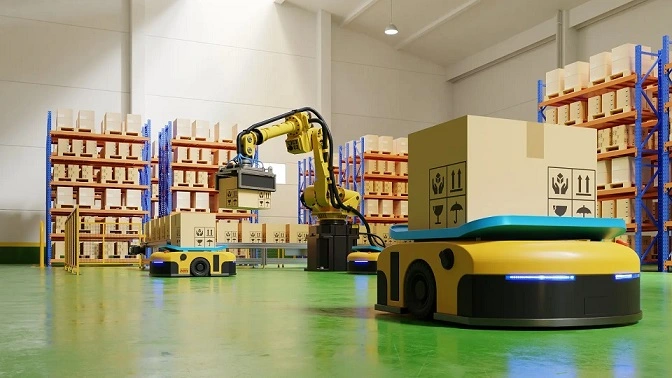Moving Towards Smarter Factories: Embracing Digitalization and Transformation.

Industries and manufacturing sectors are gradually shifting towards automation and intelligent manufacturing processes due to the influx of advanced technology. The primary focus within the industrial sector has been on enhancing productivity and output. With the introduction of new technologies, instances of unplanned downtime are decreasing, and the range and availability of control systems are expanding. By leveraging modern technology and automation, manufacturers and producers can significantly increase their productivity and output.
Virtualizing industrial plants is a strategy aimed at cutting costs, streamlining processes, and improving efficiency. To ensure reliability, fault-tolerant systems are essential in the industrial sector. Virtualization can also be utilized to support digital transformation and enhance business efficiency.
Embracing Digital Change in the Era of Industry 4.0
In simple terms, digital transformation involves integrating digital systems and technologies into traditional setups. Within the industrial landscape, digital transformation serves various purposes in elevating manufacturing processes. The overarching goals are efficiency, reliability, and precision. Dominant technologies in this domain include machine learning, artificial intelligence, digital twins, augmented and virtual reality, and autonomous systems.
Companies that have thrived through digital transformation have witnessed a remarkable increase in revenues compared to industry norms. The benefits of technology are both immediate, such as improved efficiency and quality, and long-term, including reduced costs and increased yield. Applying digital transformation brings about gains in resource efficiency, defect elimination, and safety, optimizing overall performance.
Harnessing Data Virtualization to Drive Digital Transformation
In today's world, digital data is faster, more accurate, and accessible to authorized users. This not only conserves resources but also contributes to reducing environmental impact. The goal of digital transformation is to utilize digital technologies for the betterment of society across sectors in a sustainable manner.
Before the era of virtualization, computing was dominated by single-application servers and PCs, leading to underutilization of hardware. Virtualization enables a single dedicated server to perform the tasks of multiple servers, enhancing capacity utilization. In a virtualized setting, every virtual machine (VM) on a physical server is allocated its dedicated section. These partitions are hosted on software called a hypervisor, which creates and manages virtual machines. The hypervisor oversees the core services required for running applications and the operating systems of the guests. Thus, virtualization allows multiple virtual machines, diverse operating systems, and various applications to run on a single physical server.
The Surge of Data and Enhanced Processing: Pioneers of Transformative Innovations
The surge in data and enhanced processing capabilities are driving innovations that are reshaping the very essence of production. While manufacturing generates more data than any other sector, only a fraction of organizations are effectively harnessing it. Digital manufacturing technology is poised to enable the connection of physical assets through a "virtual thread" in the coming decade.
Smart Manufacturing: Pioneering the Digital Horizon of Industrial Production
Without a doubt, Virtual Reality (VR) is a pivotal component in the trajectory of smart manufacturing. Manufacturers are striving to optimize various stages of production, from product development to post-production processes, in response to the swiftly evolving global market. To achieve this, all facets of the industrial domain should consider capitalizing on data and analytics.
The Benefits of Smart Manufacturing
Smart Manufacturing brings about disruptive transformation across the manufacturing ecosystem, with tangible advantages spanning speed, adaptability, innovation, excellence, cost-effectiveness, reliability, asset maintenance, and fuel efficiency. Inefficiencies are curtailed throughout the production cycle, starting from ideation and extending to raw material procurement and product sales.
For instance, a factory equipped with intelligent and adaptable solutions can swiftly adapt to augment or curtail productivity, facilitating quicker time-to-market for new products and greater opportunities for market acquisition. Smart Manufacturing facilitates seamless interaction and data exchange among businesses in such environments.
Challenges on the Path to Smart Manufacturing
Nevertheless, obstacles to the implementation of smart manufacturing systems encompass security apprehensions, a lack of system integration, suboptimal return on investment, as well as operational, systemic, technological, and semantic interoperability.
Yet, in the forthcoming years, industrial process automation is poised to undergo remarkable expansion as numerous nations opt for enhanced, cost-effective quality control. Machine learning is set to play a pivotal role in automating intricate procedures. Enterprises that embrace these emerging technologies are poised to set benchmarks for others to emulate. The trajectory of Smart Manufacturing will be spearheaded by Intelligent Video Analytics in conjunction with Machine Learning software.
How Digital Twins Impact Smart Manufacturing and Their Potential in the Industry
A significant driver of smart manufacturing is the digital twin, which has heralded a shift in conventional industrial paradigms. As companies strive for greater efficiency and sustainability, the necessity for large-scale capital projects grows. This necessitates novel solutions to economic and environmental concerns, centring on process simplification.
A digital twin is interconnected with its corresponding physical system via sensors. These sensors generate data pertaining toaboutical attributes such as energy output, temperature, weather conditions, and more. This data serves as a foundation for simulations, troubleshooting performance issues, and proposing potential modifications, all with generate ertinent outcomes.
Sectors engaged in large-scale projects or product development find value in employing digital twins. The Oil and gas sector is rapidly leveraging digital twins to enhance output, efficiency, and dependability. The insights and knowledge furnished by a digital twin can be harnessed to yield unparalleled financial gains.

